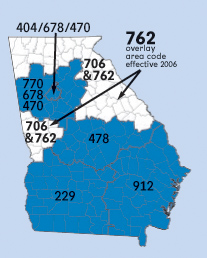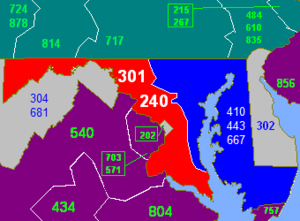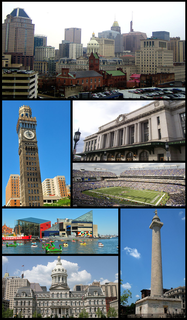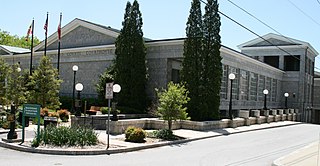
The North American Numbering Plan (NANP) is a telephone numbering plan that encompasses twenty-five distinct regions in twenty countries primarily in North America, including the Caribbean. Some North American countries, most notably Mexico, do not participate in the NANP.

Area codes 201 and 551 are telephone area codes in the North American Numbering Plan in the U.S. state of New Jersey. Area code 201 was the area code assigned to the entire state of New Jersey in 1947, when the North American area code system was formulated. After splits in 1958, 1991 and 1997, it covers the northeasternmost portion of the state, including most of Hudson and Bergen counties, bordering the Hudson River and New York City. Major cities in the numbering plan area include Bayonne, Jersey City, Hoboken, Hackensack, Secaucus and Englewood. Area code 551 is an overlay code to the same numbering plan area that was installed in 2001.

Area codes 415 and 628 are California telephone area codes for San Francisco and its northern suburbs in Marin County, and the northeast corner of San Mateo County.
Seven-digit dialing is a telephone dialing procedure customary in the territories of the North American Numbering Plan, for dialing telephone numbers in the local calling area. It is also sometimes known as local format or network format.
Number pooling is a method of reallocating telephony numbering space in the North American Numbering Plan, primarily in growth areas in the United States.
Area code 404 of the North American Numbering Plan (NANP) identifies a numbering plan area (NPA) that covers Atlanta, Georgia and its closest suburbs, roughly the area encircled by Interstate 285. It is an enclave area code, completely surrounded by area code 770, which serves most of Atlanta's suburbs. Both 404 and 770 are overlaid by area codes 678 and 470.

In the NANP, area codes 706 and 762 cover parts of northern and west central Georgia outside metropolitan Atlanta.
Area codes 615 and 629 are area codes in Tennessee serving Nashville and the 12 surrounding counties. 615 is the main area code, while 629 is an overlay covering the same area that began service in 2014. Murfreesboro, Franklin, Brentwood, Gallatin, Hendersonville, and Lebanon are other major cities in the 615/629 service territory.

Area codes 717 and 223 are telephone area codes which serve South Central Pennsylvania and the Susquehanna Valley. They cover the Harrisburg, Lancaster and York metropolitan areas as well as most of the area generally known as Pennsylvania Dutch Country—covering an area of nearly two million people.
Area codes 678 and 470 are North American Numbering Plan area codes assigned to metropolitan Atlanta, Georgia. Both area codes are overlay codes for the numbering plan areas 404 (Atlanta) and 770. No long-distance charges are applied for calls from one portion of the area to another, regardless of the area codes.

North American telephone area code 304 was established October 1947 as one of the original area codes, and serves all of the U.S. state of West Virginia. It was overlaid with area code 681, effective March 28, 2009.

Area codes 610 and 484 are telephone area codes which serve the eastern and southeastern regions of Pennsylvania. The area includes areas to the west of Philadelphia, along with the cities of Allentown, Bethlehem, and Reading. It includes much of the Delaware Valley, including almost all of Delaware County and most of the Philadelphia Main Line.

Area codes 410, 443, and 667 are telephone area codes serving the eastern half of the U.S. state of Maryland, including the Baltimore metropolitan area and the Eastern Shore. The 410 area code is the main area code, while the 443 and 667 codes are overlay codes. 443 and 667 were primarily used with cell phones and CLEC carriers such as Comcast or Cavalier Telephone when introduced but have since become universal in their carrier availability.

Area codes 703 and 571 are the North American Numbering Plan telephone area codes for northern Virginia, including the independent cities of Alexandria, Fairfax, Falls Church, Manassas, and Manassas Park, as well as all of Arlington and Fairfax counties and parts of Fauquier, Loudoun, Prince William, and Stafford counties. The main area code, 703, was created as one of the original 86 North American area codes in October 1947, and originally served the entire Commonwealth of Virginia. Area code 571 was created on March 1, 2000 as an overlay to 703.

A telephone number is a sequence of digits assigned to a fixed-line telephone subscriber station connected to a telephone line or to a wireless electronic telephony device, such as a radio telephone or a mobile telephone, or to other devices for data transmission via the public switched telephone network (PSTN) or other public and private networks.
In the administration of the North American Numbering Plan, central office code protection was a numbering policy intended to ensure that the same local telephone number was not assigned in both of a pair of adjacent communities on opposite sides of an area code boundary. Its primary purpose was initially to preserve seven-digit dialing of local calls across a common area code boundary in border communities.





















